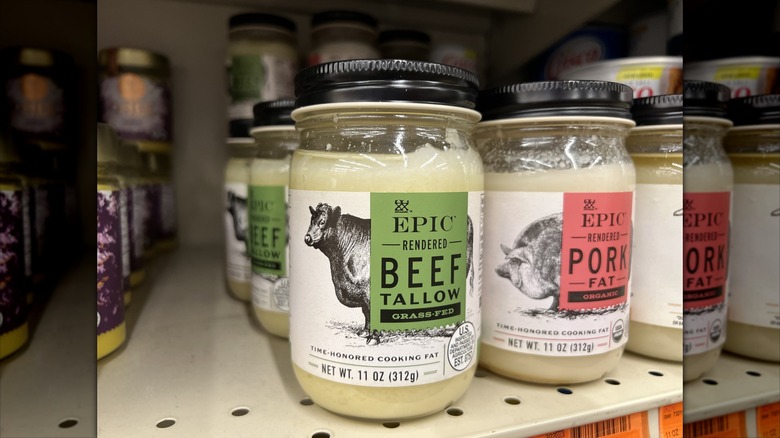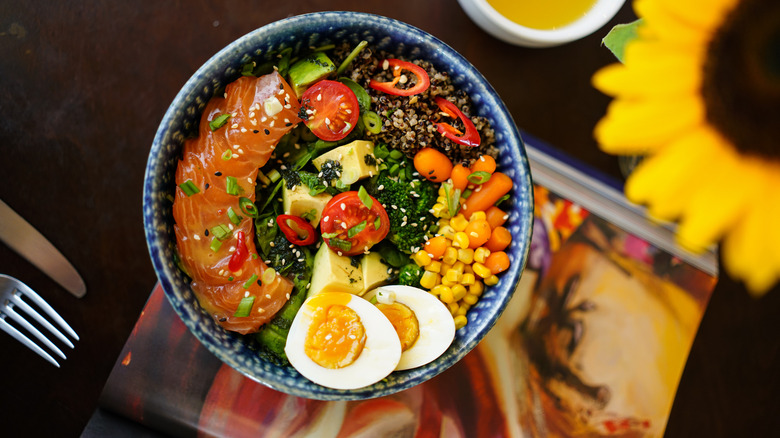
Boontoom Sae-Kor/Shutterstock
We may receive a commission on purchases made from links.
As 2025 winds to a close, it's only natural to look ahead and wonder what next year might offer. As dedicated foodies, we're particularly interested in what 2026 will bring to the table, so to speak. There are plenty of food trends we hope get left in the past, including truffles on (and in) everything and taking pics of food for social media purposes, but the year ahead looks promising where new developments are concerned.
We did some digging and uncovered a few emerging trends that we believe will be sweeping the nation throughout 2026. Overall, it seems that people want more out of the foods they buy, both in terms of nutrition and taste. Healthy eating is getting a makeover thanks to nutritionally enriched and functional foods, which are foods fortified with nutrients like vitamins and minerals. Then there's the push towards affordability without sacrificing great flavors, with store brands and fancy frozen meals leading the charge. We're even seeing a renewed interest in one old-fashioned ingredient that pairs nicely with many types of food. While there's no telling which one of these trends will have real staying power, we anticipate a wholesome and flavorful 2026.
Protein-enriched products

Lazhko Svetlana/Shutterstock
According to a survey conducted by The International Food Information Council, the percentage of Americans aiming to get more protein in their diets increased from 59% in 2022 to 71% in 2024. It makes sense that people want protein to be packed into everything, as this important macronutrient supports numerous bodily functions. Proteins are integral in the process of developing new cells, they help break down nutrients in food, and they transfer signals to different cells, among many other vital functions. Thanks to protein's essential role in nutrition and the increasing desire among American consumers to get as much of it as possible, many food manufacturers have enhanced their products with additional protein.
The nutrient can be found in coffee, cereal, snacks, and bars, as well as menu items from restaurant chains like Burger King, Panera Bread, and Starbucks. Despite protein's role in a healthy, well-balanced diet, it's possible to get too much. An overabundance of protein can lead to health problems like kidney damage and increased cholesterol levels, so be mindful of how many protein-enriched items you buy in 2026. In general, a healthy adult should be consuming 50 to 175 grams of protein each day (based on a 2,000 calorie a day diet).
A resurgence of beef tallow

Smith Collection/gado
Beef tallow is a type of rendered fat that was once a common ingredient for cooking, as well as having non-food uses in candle making and the creation of medicinal ointments. This fat has seen a resurgence on social media over the last few years and is typically prized for its high smoke point, which makes it ideal for high-heat cooking applications, such as frying. Beef tallow also gets plenty of love for what it does to the flavor of foods, as it tends to crank up the umami dial for a rich, multi-faceted taste in steaks, vegetables, and French fries.
You can use steak fat to make your own beef tallow, but you'll also find many pre-made brands online and in stores. Some tout the ingredient for its health benefits, as the saturated fat in beef tallow contains stearic acid, which isn't known to increase cholesterol levels. The concentration of monounsaturated and polyunsaturated fats in beef tallow is another reason why the ingredient is considered healthier than other types of fat. These claims may seem promising, but research continues into the rendered fat to determine its specific benefits (and drawbacks). At the end of the day, beef tallow is still a form of saturated fat. As such, it should be consumed in moderation within the confines of a well-balanced diet.
High-end frozen meals

PJ McDonnell/Shutterstock
It's true that TV dinners no longer hold the sway they once did, but that doesn't mean consumers should completely rule out frozen meals. Fancy frozen meals are becoming more relevant these days as people look for easy and affordable dishes that don't skimp on flavor. There are a few noteworthy brands in this regard, including Grumpy Butcher, Saffron Road, Evol, and Force of Nature. Costco shoppers also love the La Boulangerie Ham & Swiss Pockets, at least according to Reddit (where the product was described as "phenomenal ... crispy, buttery and delicious").
What's so different about the current crop of frozen meals as compared to the TV dinners of yore? While brands vary greatly, and many different cuisines are reflected in the selection — seasoning and spices seem to play a crucial role in the appeal of these products. By improving frozen foods with appetizing seasonings, manufacturers can avoid complaints about a lack of flavor. Similarly, the best frozen meals feature ingredients that taste fresh, even if the package has been sitting in your freezer for some time. And while you should always check food labels to determine nutritional content, there are plenty of healthier options to choose from.
Greater focus on store brands

voronaman/Shutterstock
For the uninitiated, private label products (also known as store exclusive brands) are items manufactured on behalf of a retailer. These products are often cheaper, but because they're frequently manufactured by the same companies that make popular name-brand goods, they typically offer the same — if not better — quality. There are plenty of private label brands out there, but exclusive goods from Trader Joe's, Aldi, Sam's Club, Costco, and Walmart are often highly rated by consumers. For instance, there are lots of Aldi products claimed to be better than the real thing, including Burman's Ketchup and Millville Fruit & Grain Bars.
While so-called "generic" products once held poor reputations, young people are leading the charge when it comes to private label preference. In fact, it's anticipated that Zoomers will outpace other generations when it comes to private label purchases in 2026. It's true that the appeal of store exclusives is generally growing due to the perceived quality of these goods, but a big aspect of their appeal may lie in their affordability. For comparison, a 7.75-ounce bag of Lay's Barbecue Potato Chips retails for $3.50 (via Walmart), while Aldi shoppers can score a 9.5-ounce bag of Clancy's Barbecue Potato Chips for $1.99.
More foods with functional ingredients

Kristina Truniak/Shutterstock
Functional foods and nootropics aren't necessarily new, but they're expected to make a big impact on consumers in 2026. Functional foods are nutritious items replete with vitamins and minerals to benefit one's health, while nootropics are substances claimed to positively impact thinking and cognition. Coffee is a common nootropic substance thanks to the effects it has on the brain, but L-theanine (an amino acid in certain teas and mushrooms) and citicoline (a naturally occurring brain compound and dietary supplement) are currently captivating consumers hoping to take the term brain food to an all-new level.
Functional foods can come as-is (like in the case of highly nutritious berries, salmon, and whole grains), or they can be altered to have a bigger nutritional impact. This includes fortified cereals, dairy products, eggs, and grains. Because they're packed with vital nutrients, functional foods are an excellent part of a balanced diet. As for nootropics, consumers are advised to approach any supplemental nutrition cautiously, particularly because the makers of supplements are primarily responsible for ensuring safety and accuracy of any claims made. Consider this: while research is promising for L-theanine so far, study into it and other nootropics is ongoing.



